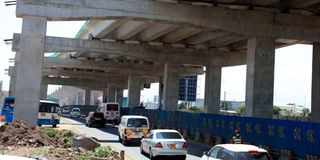Why G7 bid to counter China’s BRI will fail

The ongoing construction of Nairobi Expressway along Mombasa road on this photo taken on April 3, 2021.
Leaders of the G7 countries have set themselves on a steep climb with a proposal to rival the China-led Belt and Road Initiative. In the June 2021 Summit held in Carbis Bay, England the United States, Canada, Britain, Germany, Italy, France and Japan mooted an infrastructure development plan for emerging economies under the auspices of the Build Back Better World (B3W) plan.
G7 argues that Beijing has mustered international visibility and influence, thanks to its unyielding commitment to help developing countries improve their infrastructure capabilities through BRI.
On paper, the G7 plan looks straightforward – galvanise a partnership that can provide infrastructure funding that will help developing nations offset the $40 trillion gap by 2035; thereby dampening BRI expansion prospects. Practically, however, the US led B3W has huge obstacles that are likely to upset its implementation around the world.
The first problem with B3W is that it is largely American agenda that serves Washington more than other coalition cities. Right from the name, to its intention of containing China, many G7 countries endorsed the plan for convenience rather than utility.
It was clear from the Summit that G7 leaders hold varying perspectives on the question of how to relate with China. While the US has for instance declared China a systemic rival, France has called for cooperative coexistence.
Developing countries
The inherent divisions with the grouping make the idea of containing China hard to dribble around. Equally, B3W's obsession with rivalling Beijing takes away the focus from developing countries; which it is intended to help.
Secondly, even if the initiative were to get off, reversing the gains already made in the BRI participating countries would. With a funding portfolio in excess of $3.7 trillion covering some 2600 projects in over 140 countries and international organisations, BRI has been increasing its utility since it was founded in 2013.
The transformational scale of completed projects under the initiative has only heightened the desire of beneficiary countries to work closely with China. So far, B3W does not have a going budget. Whether it will consolidate enough resources to rival China beyond political rhetoric is yet to be seen.
Thirdly, the G7 band underestimates the comparative advantage and efficiency of China when it comes to infrastructure delivery. With top notch, yet affordable technology and human resources, Chinese enterprises continue to outbid western counterparts in infrastructure projects implementation.
In Europe, as it is in Africa, Chinese firms are implementing big ticket projects in comparatively shorter times and at competitive rates. The private sector funding that the US and allies hopes to marshal under the B3W, often prioritize profitability and are therefore not likely to be competitive against Chinese enterprises.
Fourth, BRI is more than the often talked about infrastructure construction. At its core, the initiative is emblematic of the inordinate socioeconomic transformation of China and the resulting goodwill that Beijing has extended to other developing nations.
Colonial sentiments
BRI allows emerging economies to learn from China while tapping into the opportunities arising from China’s decision to share the proceeds of its development with the rest of the world. The Chinese development model and its accompanying success is a strong force of attraction that countries with similar aspirations just can’t wish away.
Fifth, the US-led coalition is stoking colonial sentiments in which the so-called democratic values and ideals will be the centrepiece to its engagement with the developing world. By designating spheres of influence for the G7 members, it limits the range of choices that developing countries would have; a sharp contrast to BRI which remains participatory, voluntary and inclusive.
Developing countries want partners that will engage on the bases of equality, mutuality, respect, and shared benefits. B3W comes with a preconceived checklist that countries must meet in order to participate.
Finally, the B3W is premised on powering green infrastructure development around the world. So far, China is the largest producer and investor of green technologies. China invested more in green energy through BRI than in traditional energy sources in 2020, for the first time, according to a report by the Financial Times. Over 60 per cent of the $11 billion energy investments in the BRI projects went into green energy.
China’s ambitious climate change mitigation measures and the greening component of the BRI puts Beijing in a good position to effectively compete in the realm of green development.
Twitter: @Cavinceworld.





